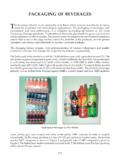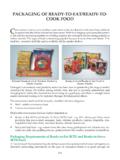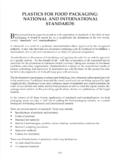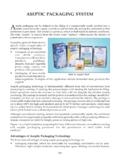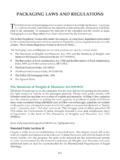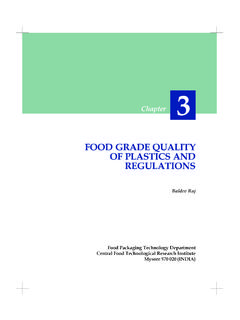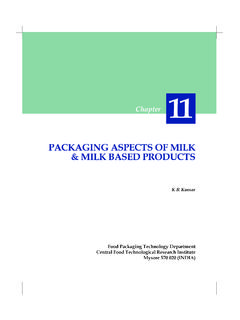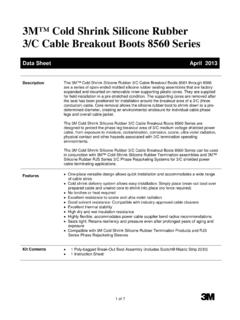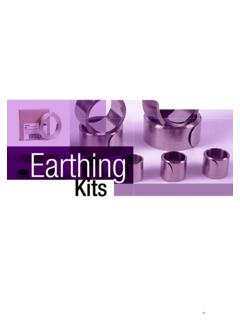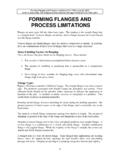Transcription of SHRINK PACKAGING AND STRETCH WRAPPING - ICPE
1 341 SHRINK PACKAGING AND STRETCHWRAPPINGA mong the specialised plastic PACKAGING systems, SHRINK PACKAGING or commonly knownas SHRINK WRAPPING and STRETCH WRAPPING are very common and widely used. Thoughthere are some apparent similarities in the two systems, in overall analysis, they are consideredto be totally different in terms of material and the case of SHRINK WRAPPING , SHRINK film is used as the basic material and heat forms animportant part of the operation, whereas, in the case of STRETCH WRAPPING , STRETCH film is used asthe basic material and no heat is applied during the operation. SHRINK WRAPPING is done in 3 or4 stages, namely: WRAPPING (sleeve WRAPPING or over- WRAPPING ) sealing (necessary only for over- WRAPPING ) shrinking (with application of hot air), and coolingStretch WRAPPING is done only in two stages, namely, WRAPPING and sealing (most of the time even without asealer).
2 However, in many PACKAGING applications, both thesystems are considered as alternative to each other. Thesesystems are mainly used for unitisation, but sometime theyare also being used as primary PACKAGING system. Both thesystems are used for bulk PACKAGING as well as fact, both the systems are now being used for some major applications like sleeving forlabelling on various containers or sealing, besides both the PACKAGING systems, material plays an important role, because without thecorrect material, proper SHRINK or STRETCH WRAPPING may not be possible. It is therefore,absolutely essential for anyone involved with the subject to either learn about the technicalspecification of the materials or work very closely with the material supplier, used for SHRINK / STRETCH WrappingShrink and STRETCH WRAPPING can be quite complex in their structure.
3 Most of the packagingfilms that are used for SHRINK and STRETCH WRAPPING are from the polyolefin range. These arematerials produced from oil based chemicals by what is called a polymerization process, whichbasically means getting the right molecules and atoms to club together in a way that is requiredShrink Pack342or desirable for a particular application. The most common plastic materials are polyethylene,polypropylene and poly vinyl is comparatively less used in SHRINK and STRETCH WRAPPING , because it is slightlyharder than the other commonly used materials. It has a higher melting temperature and isless stable when shrinking. However, many over- WRAPPING machines use polypropylene andsome can be put through a SHRINK tunnel to give a slight tightening is a dense material. As most polymers are sold by weight and there has been ecologicalpressure in Europe and America against its use, sometime use of PVC is restricted.
4 However,it is still considered to be a common material in India, when clarity is an important selectioncriterion, particularly for consumer is the most commonly used materialfor SHRINK and STRETCH WRAPPING because it isrelatively cheap and can be produced in a range ofdifferent densities and modified with additives toperform many vast majority of SHRINK film is LDPE and someof the more sophisticated films have blends ofLLDPE as well. Sometimes a little quantity ofHDPE material is also selection of plastic material, besides type ofplastics, the yield of the film is also important to be considered from the economy point ofview. The yield means the area obtained or number of square meters of film converted from akilogram of material of a given thickness or gauge may be expressed in micron ( mm), mil (an American terms for thousandthsof an inch inch) or simply gauge, which is the old British system where 100 gaugeequals one thousandth of an inch.
5 The co-relation of both the systems of measurement ofthickness is 25 micron (or mm) equals 100 gauge (or inch).For SHRINK film, the next important factors considered are the shrinkage and the slip of the means the percentage SHRINK in the machine direction, along the reel of the film,and also in the transverse direction, across the reel of the film. The slip can be of differenttypes high, medium or low depending upon how much slippery property in the film is requiredfrom the operational point of view. Usually, low slip is SHRINK WRAPPING small packs at high speed, particularly for consumer products or displaypurposes, PVC or specially modified Polyolefin may be used. The high SHRINK films arecrystal clear but generally STRETCH WRAPPING , majority of films are modified linear low density polyethylene (LLDPE),often three-layer extrusion with tackifier added to make them sticky on either one or bothsides.
6 Some PVC films are also Asparagus - STRETCH Wrapped343 Plastic Films UsedIn short, following plastics films are commonly used for SHRINK and STRETCH WRAPPING :Polyethylene Used almost exclusively or as a combination of LDPE + co-polymers EVA (ethylene vinylacetate) or EEA (ethylene ethyl acrylate).Copolymer Modification: LDPE is sometimes modified by addition of EVA and EEA (upto 8%). EVA is approved by US-FDA for direct contact with food. EEA is approved up to7% for direct contact with food. However, Vinyl Acetate (VA) or Ethyl Acrylate (EA)content is normally restricted to 3-4%. Irradiated polyethylene film containing EVA, shrinks strongly in boiling water and isgenerally used for WRAPPING chickens. In the form of mono-layer or 3/5 multi-layer, 3 layer wide SHRINK films of HM-HDPE(rolls/bags), LLDPE (rolls), etc. are available for palletized goods; Diameter > 5m andLay Flat Width (LFW) > 10m; Film shrinks in area and increases in thickness.
7 This isusually used for protection of industrial products from dust, contamination, rain, required for shrinking PE film: about 200 C for 100g film and 300 C for and PP Used for foodstuffs ( meat and vegetables). Both are also used for non-foodapplications, where increased transparency and gloss justify the increased price incomparison with of SHRINK FilmAlmost all plastic films SHRINK to some extent. In most PACKAGING applications, dimensionalstability is desirable and shrinkage is considered to be detrimental. However, in some packagingapplication, controlled shrinkage is deliberately used for certain objectives to be fulfilled. Forexample, SHRINK film is used to pack products with a tight pilfer-proof wrap over carton andboxes, so as to utilize number of packs or items on pallet, etc.
8 A variety of shrinkable filmshave been developed to meet the requirements of many different end-use film is made by stretching or orienting a conventional film at a temperatureclose to its softening point ( Tg) and then quenching or freezing the film in the orientedstate. The film that undergoes a special stretching and cooling process, causes an orientationin the film and introduces frozen-in shrinkage stresses, which can be given hot air treatmentor infra-red 1 shows a schematic representation of a single long-chain polymer molecule in therelaxed and considerably curled state that is characterised in an un-oriented the same film isstretched uni-axiallyoriented in one directionwhile it is heated,randomly twisted andintertwined moleculesline up as shown infigure , if the film isstretched not only in themachine direction, butalso in the transversedirection, there will besome orientation ofmolecules at intermediateangles, but the majoritywill line up as , orientation isimparted by blown-filmextrusion process or ontenter frames.
9 When thefilm is quenched after orientation, the molecules are frozen in the oriented position, but theystill remember their original shape or regain their memory to return to that shape if the film isreheated or exposed to the orienting temperature. When this does happen, obviously the filmshrinks around the FilmStretch film is defined as stretchable, elastic, continuous thin plastic film, which is stretchedand wrapped around one or more items to protect them from the environment or unitize forhandling, storage or shipping. STRETCH film is also used to some extent for bundling smallerunits and lumber. They are also used for super market tray general, STRETCH film means a collective name for all types of plastic films, which are wrappedround a package under some form of mechanical stretching. It is a film, which can be cold-stretched in longitudinal and transverse directions without application of heat and whichwhen stretched round a pack maintains a tension for a long period.
10 A strong degree of transverseorientation gives STRETCH film a good extensibility in longitudinal direction and an increasedtotal films entered the market in the early 1970s as a replacement for SHRINK wrap, used tounitize non-returnable glass bottles, pet jars in a tray, etc. The most common type of stretchfilm is the cling type which is easy to use since the WRAPPING is completed by cutting the filmbetween the load and the film roll and merely wiping the loose tail of film against the film to film adhesion cling, holds the tail in place. Other less common way of attachingFigure 1: Polymer MoleculeFigure 2: Polymer Molecules in Uni-axially Oriented Film345the film tail are adhesives, heat sealing,mechanical fasteners and andDisadvantages of StretchWrapAdvantagesCompared with SHRINK film and bags, STRETCH WRAPPING affords large energysaving and does not require theavailability of fuel.
